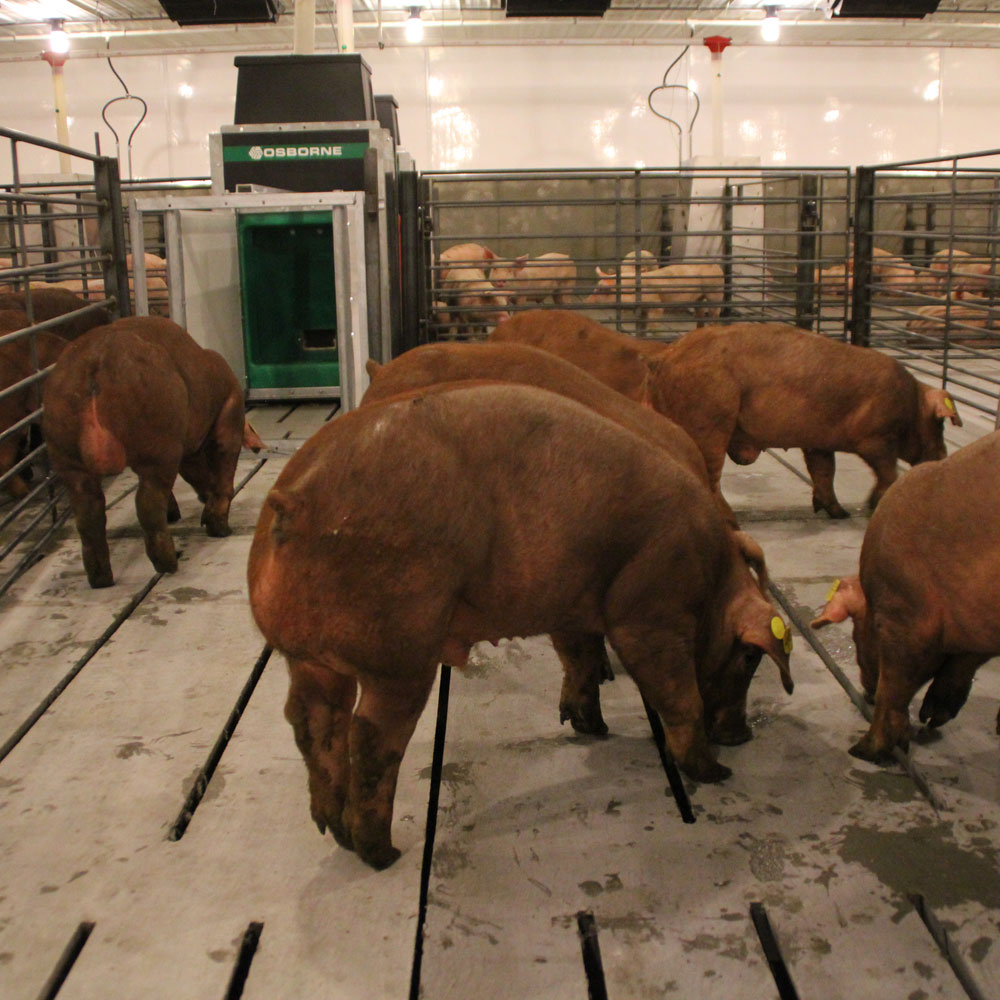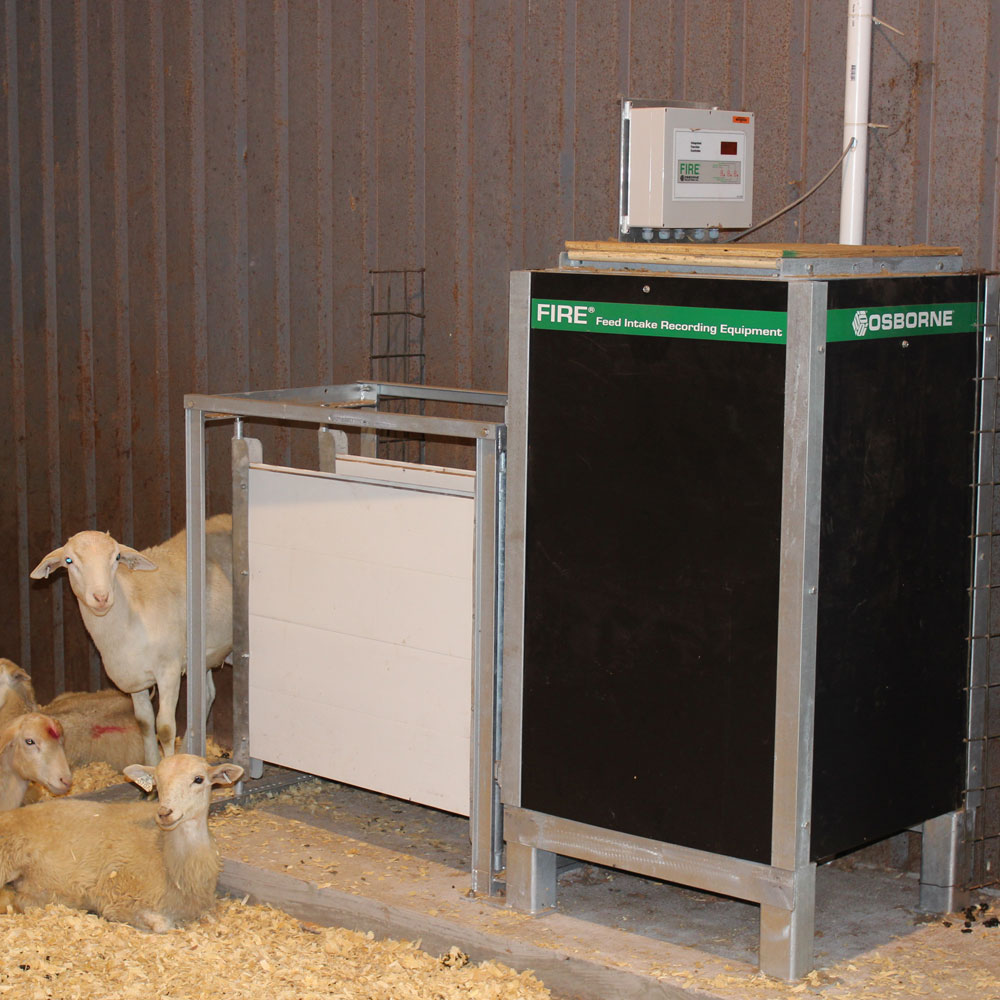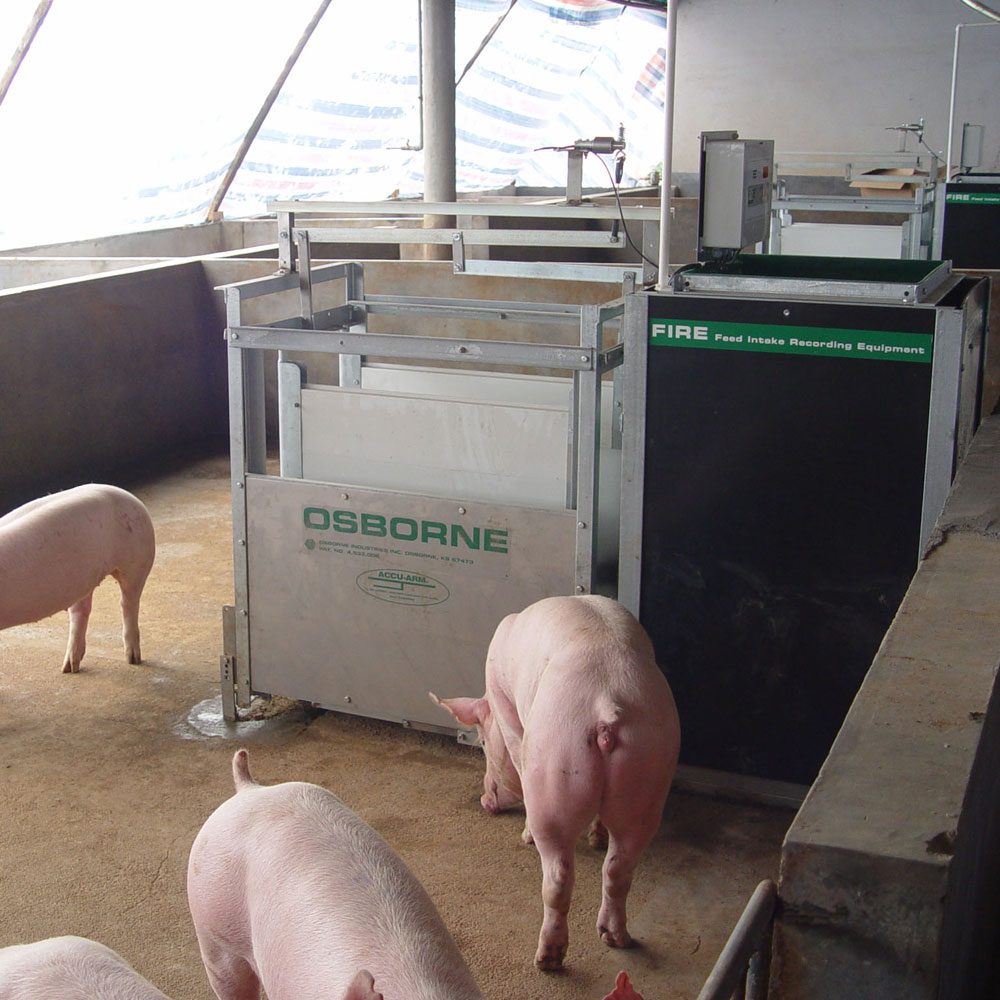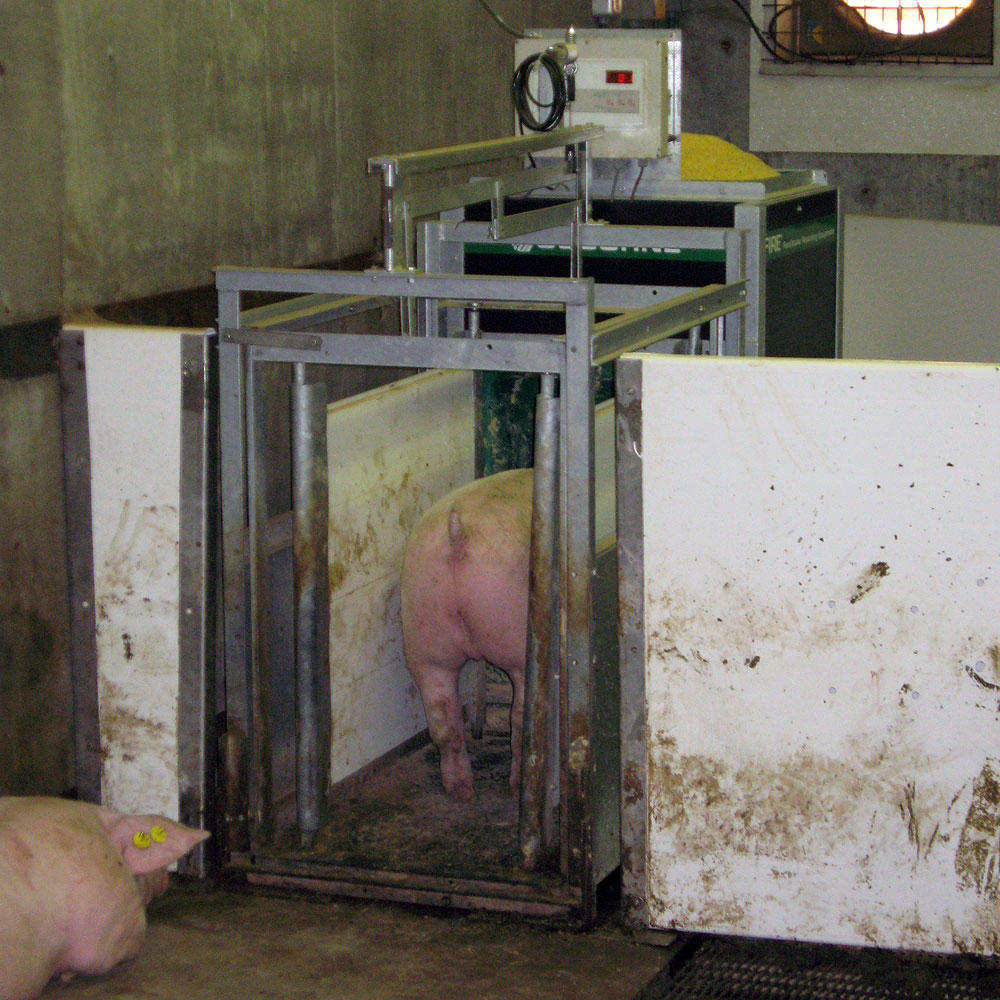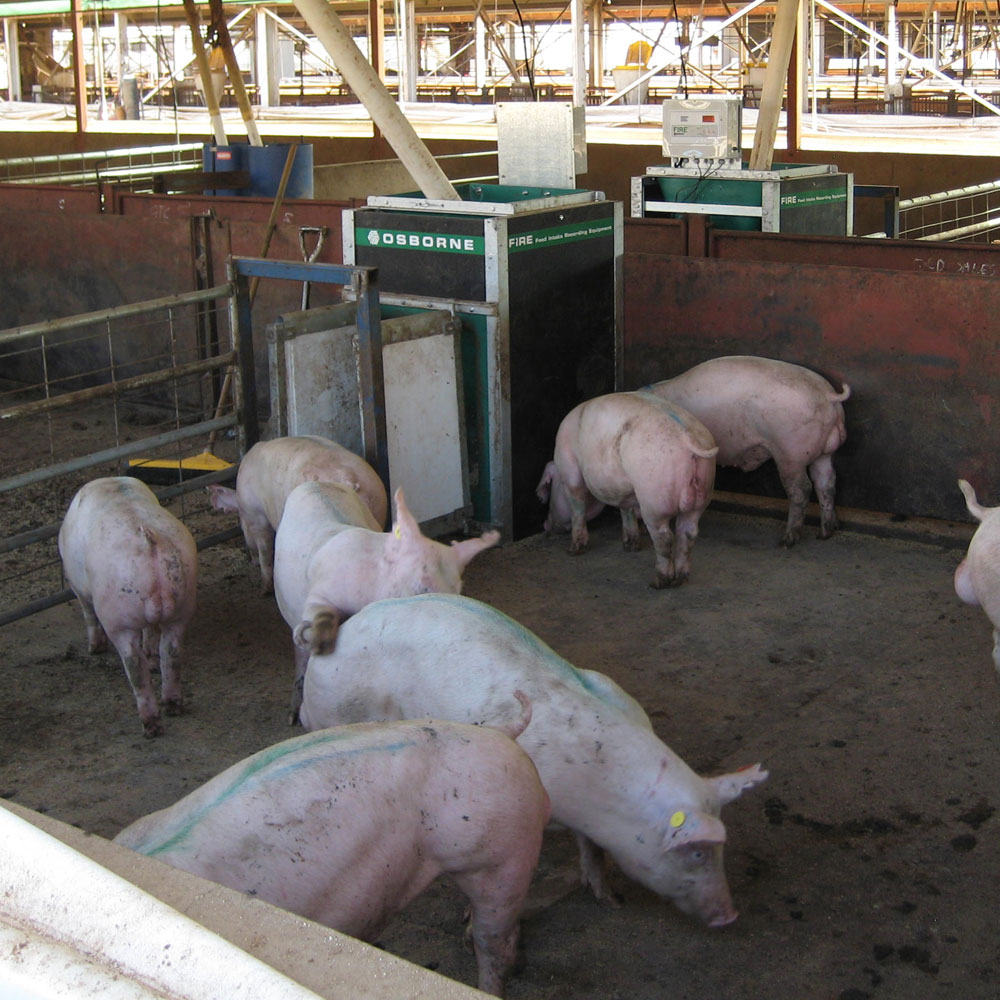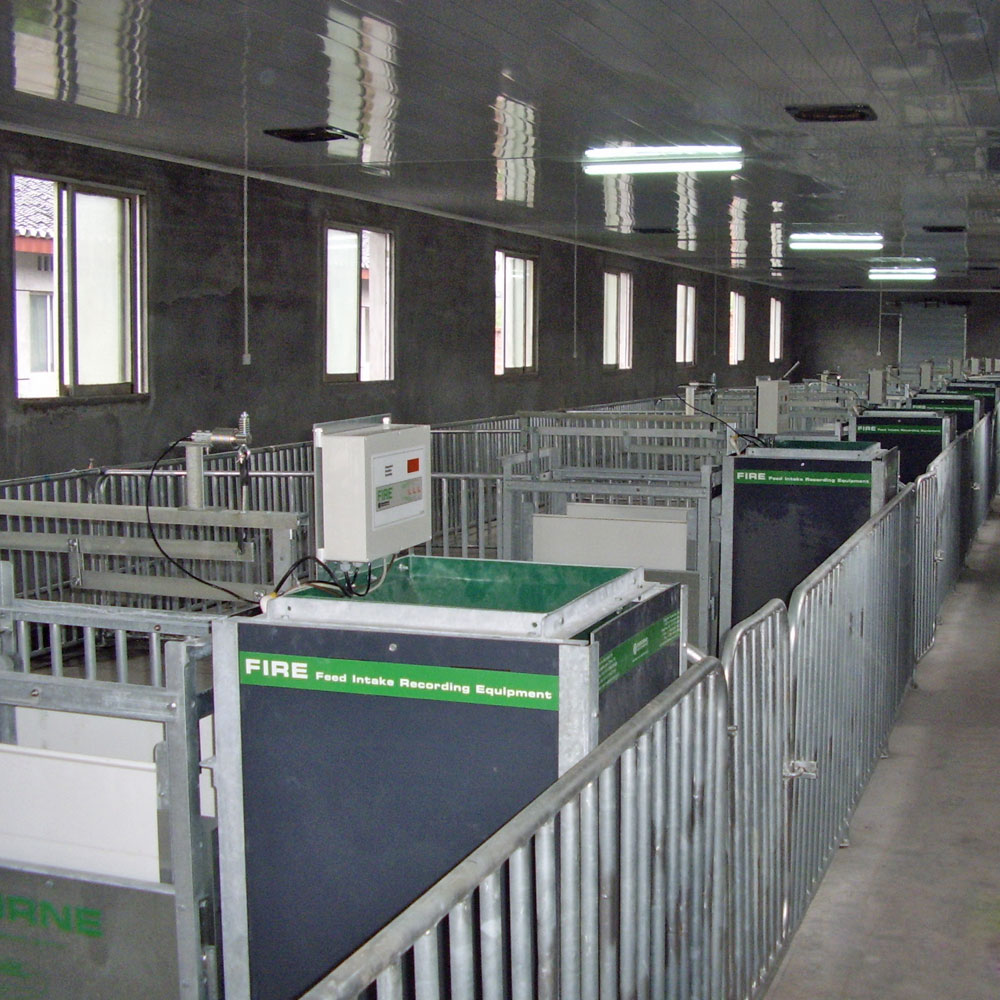FIRE
For nearly 30 years, Osborne's FIRE (Feed Intake Recording Equipment) performance testing system has helped shape the genetic makeup of pig herds all over the world by identifying the most efficient animals. Testing with FIRE is fully automated and accurately simulates commercial production to provide the most accurate feed intake and growth data used for genetic, feed, and pharmaceutical testing of pigs, sheep, and goats.
About
FIRE automates the measurement of individual daily feed intake and other performance characteristics of growing pigs, sheep, and goats, eliminating labor-intensive, manual methods of recording feed intake and animal weights. Leading genetics companies, research facilities, and universities rely on the accuracy of FIRE to identify top-performing animals for genetic selection, test feed additives and non-traditional feedstuffs, test vaccination regimens, and test the effects of changes in management and environmental variables.
With FIRE, animals are housed in groups, accurately simulating real-world, commercial production. Each animal is uniquely identified at the ad-lib feeding station and all visits, visit durations, and amount of feed consumed is automatically recorded for further analysis. With thousands of units in use all across the globe, trust FIRE to provide the accurate data you need for sound decision making.

FIRE Performance Testing Feeder
FIRE (Feed Intake Recording Equipment) is the original performance testing feeder for pigs, sheep, and goats and fully automates the measurement of individual animal daily feed intake. The feeder’s feed trough is suspended on a sensitive, yet robust, load cell that continuously weighs the trough and feed. The trough mount and load cell are protected by an isolation mechanism and a sturdy enclosure that houses a highly accurate feed dispensing system. FIRE automatically stores the time and duration of each visit, along with the weight of feed consumed.

Protective Races
A variety of protective animal races are available to shield individual animals visiting the FIRE Feeder. While FIRE may be used as a stand-alone ad-lib feeder, protective races reduce the chance dominate animals might produce atypical results during a test. These protective races, ranging from simple shoulder-length shields, to full-body races with integrated animal scales, provide protection as each individual animal visits the FIRE Feeder to eat. Each race helps FIRE Feeders simulate commercial, multi-opening feeders more accurately.

WinFIRE RT Software
The WinFIRE RT Software application for Windows collects, stores, and displays all the information collected by the FIRE System for monitoring feeder operation, reviewing animal or group feed intake information, individual growth trends, and more. Real-time and even remote access to up-to-the-minute data collected by FIRE is possible with WinFIRE RT and is included with all new FIRE Systems.
Each FIRE Feeder in a pen accommodates 12 to 15 animals beginning at 50 lbs. (23 kg). Because FIRE uses RFID (radio frequency identification) technology to identify animals, each animal is tagged with an RFID tag. An antenna inside the FIRE Feeder identifies animals at the feeder by their unique RFID. Total feed intake of each individual animal is recorded as it visits, and when equipped with an ACCU-ARM Weigh Race, the individual weight of the animal is recorded. The WinFIRE RT Software maintains a database of information collected in real-time from FIRE for each individual animal. WinFIRE RT allows users to make sound genetic selection, management, financial decisions.
Leading geneticists rely on FIRE to assist in identifying superior-performing animals. FIRE allows for complete and accurate optimization of genetics and clear insight into breed lines that lead to the most efficient animals possible.
Because FIRE automates the measurement of both feed intake and growth performance, older, manual methods of testing animals is completely eliminated. Testing with FIRE faithfully simulates actual commercial production practice. FIRE has been successfully used with pigs, goats, and sheep.
- Completely automates the measurement of individual feed intake and growth performance
- Accurate commercial production simulation
- More accurate than manual testing animals in single pens
- Eliminates data collection errors and operator bias
- Provides diagnostics for animal health and behavior
- Effectively tests pigs, sheep, and goats
- Separate, sensitive load cells accurately weigh feed and animals
- Strong construction for years of use
Literature
FIRE Pig Performance Testing Informational Brochure: English | Spanish | Portuguese | Russian
Frequently Asked Questions: FIRE: English | Spanish | Russian
Benefits of FIRE: English
Accuracy & Precision of FIRE Pig Performance Testing Feeder: English | Russian
Technical Note: Using FIRE to Improve Feed Ration Plans: English
FIRE® Performance Testing for Sheep and Goats Informational Brochure: English
Research
Abstract: Using sentinel pens with performance testing equipment as a tactical management tool: English
Feed Intake Pattern of Group-Housed Growing-Finishing Pigs Monitored Using a Computerized Feed Intake Recording System: English
Effects of Feed Type, Space Allowance, and Mixing on the Growth Performance and Feed Intake Pattern of Growing Pigs: English
Monitoring Growth and Statistical Variation of Grow-Finish Swine: English
Feeding Behavior of Yorkshire Pigs Selected for Residual Feed Intake: English
Press Releases
PIC Expands Use of FIRE® System to new Genetic Nucleus: English | Chinese
PIC Australia Installs FIRE® System: English | Chinese
Chinese Feed Company Invests in Research Technology: English
Large Chinese Pig Producing Company Expands Use of Performance Testing Equipment: English
The FIRE Feeder will accept up to 12 animals per station if meal feed is used. The station will accept up to 15 animals if pelleted feed is used. Feeding more animals on the station than what is recommended can put additional feeding pressure on the animals, which will influence and bias the results to a particular behavior type. It is recommended that pigs be between approximately 60 lbs. (30 kg) and 300 lbs. (140 kg) to use the FIRE Feeder. For pigs smaller than 60 lbs. (30 kg), SaFIRE (Small Animal Feed Intake Recording Equipment) should be used.
The FIRE Feeder is designed to operate in a livestock environment. Exposure to dust, dirt, high humidity, corrosive gasses, and manure is expected, and the equipment is designed for this, with sealed electronic and electrical components, and plastic and hot-dipped galvanized steel/304 stainless steel structural components. Periodic cleaning is required to remove built-up manure and debris from around and under the FIRE station and FIRE weigh scale to prevent interference with the weighing mechanisms, though several upgrades to the system over the years have resulted in significant reductions to sanitation time.
Osborne offers several options for protective races that provide different degrees of protection to an animal eating at the feeder. Using no race on the FIRE Feeder allows animals unhindered access to the feeder, but exposes the animal from both sides and the rear to other animals in the group. Using a shoulder-length race on the FIRE Feeder provides a visiting animal with protection from their shoulders forward, but exposes the animal on its rear half. The full body race or ACCU-ARM Weigh Race provides a visiting animal with protection from all sides, except the rear. These two options provide the greatest degree of protection to a visiting animal without confining each animal to prevent competition. The greatest factor affecting the “bullying” behavior with a FIRE Feeder is the number of animals placed in the pen. Staying within the recommendations of 12 to 15 animals per station typically eliminates the bullying behavior problems by allowing plenty of time for all animals to visit the FIRE Feeder and eat.
FIRE is an ad-libitum feeding system. A small amount of feed is always maintained in the feed trough. The trough is constantly weighed so that any disappearance of feed can be recorded as a consumed meal. If the weight of the trough falls below a set value, an additional portion of feed is dispensed into the trough. The accuracy of feed consumption while dispensing feed during a meal is maintained through the use of the system’s proprietary Dynamic Portion Calibration (DPC) algorithms.
A small amount of feed is always maintained in the trough of the FIRE Feeder. Feed consumption, or feed disappearance, is recorded for each animal visit. In the case where one animal displaces another which is currently eating, a trough weight is captured between the end of the first visit and the beginning of the second visit, allowing the system to accurately record each animal’s meal independently. When the same animal visits the feeder within a five minute time period, the events are merged and recorded as a single visit to the feeder.


